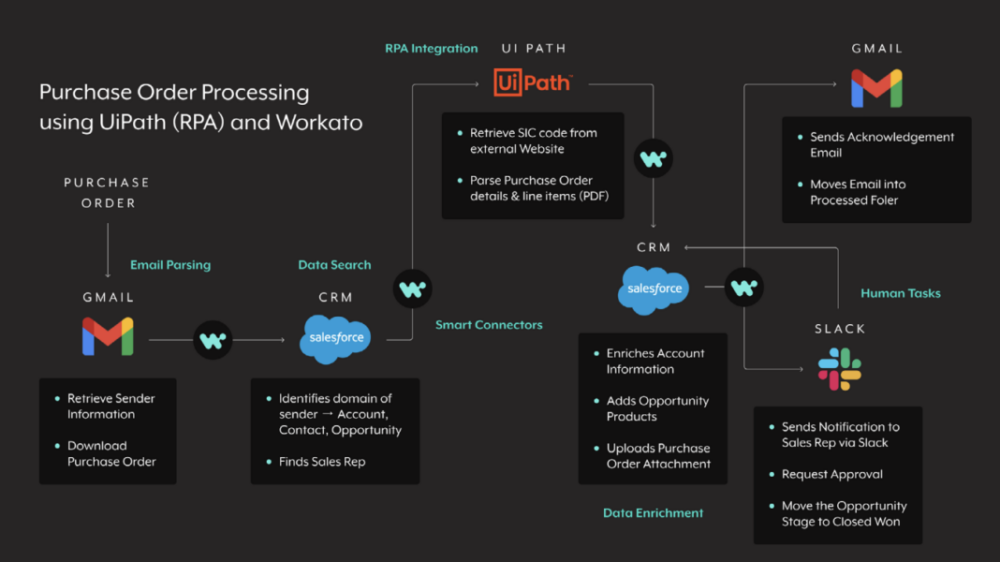As business leaders experience economic headwinds, they’re—according to recent survey data—automating more of their business processes.
Their reasons for doing so aren’t difficult to discern: Automation offers efficiency improvements and cost savings. And, if done right, it can help organizations transform their processes, allowing them to be agile and innovate.
As part of determining the automations they need, organizations have to decide if they want to adopt RPA software or a workflow automation tool (or both).
We’ll help you navigate this exercise by reviewing each and by directly comparing them. We’ll then present another type of solution that allows you to leverage RPA as part of a workflow automation.
What is RPA?
RPA, or robotic process automation, is a type of software that uses “bots”, or software scripts, to mimic human tasks at the user-interface level. The tool can be delivered in the cloud or on-premises, and, depending on the vendor, it can come with additional features, like intelligent document processing (IDP).
To help illustrate how, exactly, RPA can work, let’s use an example:
A software bot can be programmed to copy fields from a specific spreadsheet, log into a 3rd-party application, like Salesforce, create a new record, and paste the copied data into the corresponding fields within that record. Moreover, if the bot is unattended, it would perform this task at a predefined point in time, whereas if it’s attended, human intervention is required to spur it into action.

Pros:
- It can work across a broad range of systems, including legacy systems that don’t offer APIs.
- It can automate a wide range of tasks—allowing it to be used in a variety of ways.
- Assuming your applications’ UIs don’t change frequently, it can work effectively.
Cons:
- The bots can be relatively fragile. A small change in an application’s UI, for instance, can be enough to break a bot.
- It doesn’t fundamentally change how a process is carried out. In other words, if a process is faulty or less-than-optimal, RPA won’t necessarily improve it (in fact, it may exacerbate the processes’ issues).
- As more tasks need to be automated, more bots will need to be built and managed. This requires investing in technical resources, which may come at a high cost.
Related: 3 common problems of using RPA
What is a workflow automation platform?
It’s a type of platform that can automate a business process end-to-end. More specifically, it can listen for business events (or triggers), where once any takes place, it can carry out the appropriate set of actions across your applications, data, and employees.
The following employee onboarding automation can help clarify this definition:
Once a candidate is marked as hired in your ATS, the workflow gets triggered. The new hire would go on to get added to various systems, including your HRIS, ITSM tool, and identity and access management platform. In addition, the new hire would receive an email on their first day that welcomes them, shares valuable resources, and provides them with a list of tasks they need to complete during their onboarding.
Related: What is process orchestration?
Pros:
- It can fundamentally change how a process is performed—for the better.
- It can provide the actionable insights employees need to make intelligent decisions, quickly.
- It allows employees to stay in the application they’re already working from (their business communications platform).
Cons:
- If an application doesn’t have APIs, the workflow automation tool may not be able to connect to it.
- Assuming the tool doesn’t offer a low-code/no-code UX, the majority of business users won’t be able to use it. As a result, automation bottlenecks can quickly emerge, and friction between the teams that need automations and those that build them can form.
RPA vs workflow automation
In short, RPA software allows you to work with any number of systems, regardless of whether or not they provide APIs, allowing it to (potentially) interact with more tools than a workflow automation solution. However, workflow automation tools allow you to transform processes, which can carry greater benefits to your teams and to your business than task-based automations.
Related: How to decide between an iPaaS and RPA software
Get the best of both tools with Workato
Fortunately, you don’t have to choose between RPA and workflow automation solutions.
Using Workato, the leader in enterprise automation, you’re able to address the drawbacks of both tools as well as build workflow automations that leverage RPA.
Here’s just one example of how this can be work:

1. Once an email service provider receives a purchase order, the workflow gets triggered.
2. Workato downloads the purchase order and, using the sender’s email address, identifies their associated contact, account, and opportunity pages in your CRM.
3. An RPA bot searches for the opportunity’s Standard Industrial Classification (SIC) code from a 3rd-party site. Once found, the bot uses it to enrich the opportunity.
4. The purchase order is parsed by both the bot and OCR technology in order to find the products and services the client purchased. Once found, the bot adds them to the opportunity. Workato also uploads the purchase order to the opportunity.
5. Workbot, our customizable platform bot, notifies the assigned sales rep of the PO via a message in your business communications platform. Within the message, it also asks them to approve or reject it.
6. Assuming the sales rep approves the PO, Workbot changes the opportunity’s status to “Closed Won.” It also emails the client, letting them know that their order has been processed successfully.

Want to learn more about Workato?
Discover how the platform lets you implement powerful end-to-end automations safely and without having to write a single line of code.
